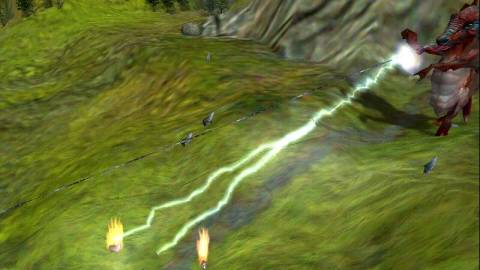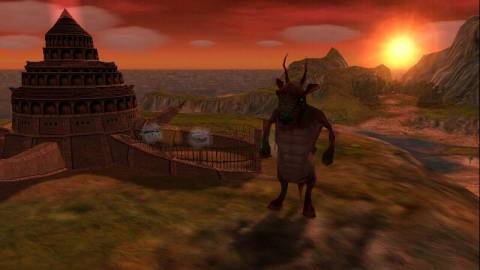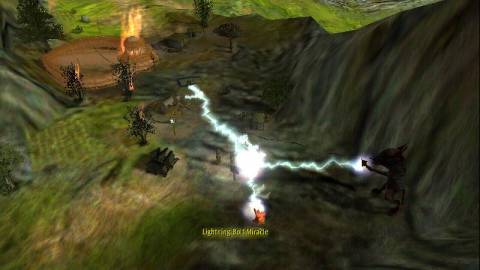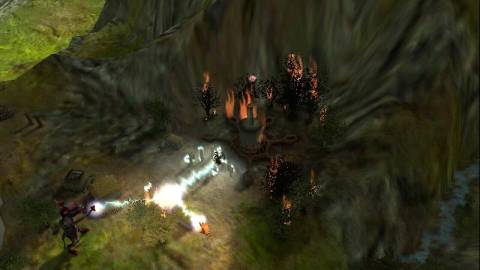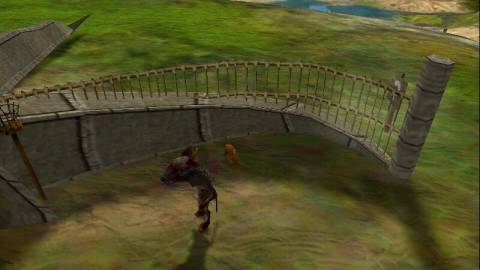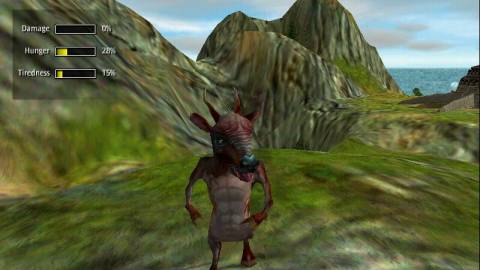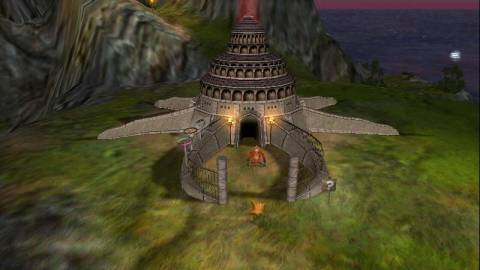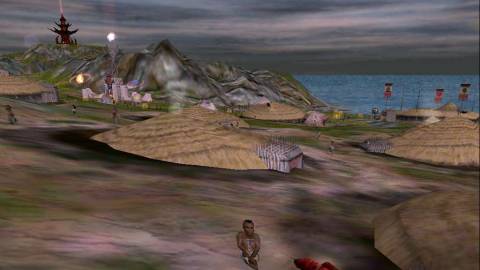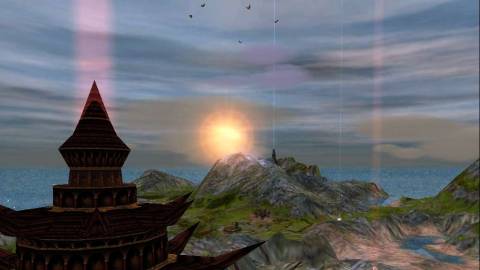Overview
Black & White is an ambitious and unconventional real-strategy game developed by Lionhead Studios under the personal supervision of legendary game designer Peter Molyneux. Taking on the role of a newborn God, players are tasked with managing the needs of the mortal population, using a gesture-based casting system to perform miracles and attract new worshipers, and raising a unique anthropomorphic Creature governed by an adaptive artificial intelligence. The methods employed by the player in pursuing these goals are judged by the game's built-in morality system, and over time the color palette and architecture will gradually change to differentiate beneficent gods from malevolent ones.
Multiple publications within the gaming industry lauded Black & White as the best strategy game of 2001, and it won awards for “Best PC Game of the Year” from the and Sciences, The New York Times, and PC World, among others. In the weeks following its release, however, many gamers came to criticize the repetitious nature of the gameplay, the tedious quest system, and severe stability problems which resulted in frequent crashes and unwinnable tasks.
Gameplay
Black & White’s gameplay mechanics differ from traditional real-time strategy games in several ways, most notably in the areas of interface, resource management, and the possession of a single unique unit which is given to acting on its own individual whims.
Interface
In an attempt to create a completely intuitive experience, Black & White was designed around a very minimalist interface. On-screen buttons and menu icons are virtually nonexistent, and all the information regarding resource levels are represented graphically in the game world itself. Food and wood stockpiles in a given village, for example, appear as flags on the local store which will raise or lower depending on the people’s needs.
All interaction in the game world can be accomplished through the use of a divine hand which is directly controlled using the mouse. Players can use this to pick up, drop, or toss objects, interact with their Creature, and invoke several different miracles using a gesture recognition system. Each miracle has its own specific motion: tracing a heart-shaped path with the hand will queue up Miracle Heal, while shaking it rapidly forwards and backwards will prepare Fireball. Most miracles have a pre-defined area of effect, but a few allow the player to draw out a circle with the hand to specify their range.
The game is not devoid of conventional controls, however. Keyboard shortcuts exist for every miracle in the game, as well as for zooming swiftly between city centers, locating the Creature, and accessing the Options and Save Game features inside the Citadel.
Resource Management
A typical map in Black & White features a large island landscape dotted by several villages of indigenous people and one Citadel for each human or AI-controlled god in the game. Villages that worship a player project a visible sphere of influence around their town centers that define the area in which that player is able to directly interact with the world. Belief is an intangible resource that players want to cultivate in order to sway neutral villages to worship them, then to expand the radius in which they’re able to perform miracles and build new structures. Mortals are most impressed by flashy miracles so cultivating belief in a village too far outside the current ring of influence can be very challenging, but a well-trained Creature can be taught to how to convert non-believers in distant areas.
Once a village falls under a player’s dominion, the people themselves become a necessary resource. Humans cannot directly fight, but the more inhabitants a village has, the larger the sphere on influence around its city center grows and the harder it is for an enemy god to win them over. They can also be mobilized to actively worship at the Citadel to generate the mana necessary to perform miracles.
In addition to using mana to magically generate food and wood for the villagers, individuals can also be ordained as disciples who will tirelessly farm, fish, chop, or breed in service to their deity. Each village must be managed separately, and since control of different townships tends to grant access to additional miracles, players will often need to devote a significant amount of time to managing their needs.
The player’s treatment of the mortal population is the primary factor in how the game determines his or her alignment. Brutalized people tend to work harder, but often suffer from lower numbers and can be more easily swayed by a god who demonstrates a bit of compassion.
The Creature
Shortly after beginning the game, players gain ownership of a complex artificial intelligence in the form of an anthropomorphic Creature. Three species are available from the start, including a benevolent cow, curious ape, and aggressive tiger, but there are over a dozen different types in the game with their own natural predilections.
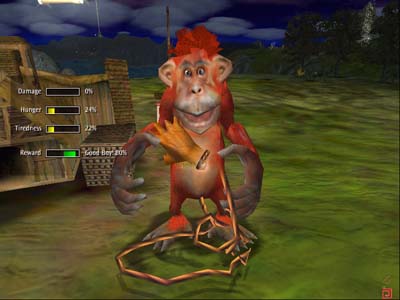
Creatures grow and adapt over the course of the game, both physically as they eat, sleep, and exercise, and mentally as players teach them new abilities and behaviors. They’re emotional beings, often demonstrating natural curiosity, frustration, anger, fear, compassion, and delight depending on their circumstances, but by using the divine hand to gently pet or viciously beat their Creature, players can gradually train them to act in particular ways.
Unlike gods who are limited to affecting things near their spheres of influence, Creatures can learn to perform miracles on their own and travel anywhere on the map to invoke them…if they feel like it. Well trained Creatures can be coaxed into entering a remote village and working hard to impress the population on behalf of their owner, while ill-tempered ones are more likely to snack on a few loyal citizens before wandering off for a long nap. Players can attempt to direct their Creature’s attention through the use of leashes that encourage aggressive or kindly behavior, but its behavior is ultimately governed by its own desires.
Creatures can interact with each other in a few different ways, but when two decide to do battle, Black & White adopts the guise of a simplistic 3D fighting game in which human players can queue up a series of attacks or blocks to guide their Creature to victory. If it knows any useful miracles such as Fireball or Heal, Creatures can also be prompted to cast them in combat.
Presentation
Black & White employs an auto-scaling graphics engine which allows the view to pull back to a point several miles above sea level and smoothly zoom in far enough to see a single worm wriggling into an apple at the village store. Even on hardware available in 2001, it was capable of handling landscapes with hundreds of trees swaying gently in the breeze, several dozen tribal buildings, and hundreds of individually tracked humans.
One of the game’s signature features was the way the presentation would gradually change to reflect the player’s alignment. This was most pronounced in the appearance of the divine Citadel which would morph into a sharp and foreboding fortress for cruel gods, or a shining silver tower for good ones. A more subtle change was the way the color palette would become darker and shift towards red in evil territory, but appear brighter and more idyllic inside a good player’s sphere of influence.
Creatures also change with time, literally growing up over the course of the game into enormous skyscraper-sized figures many times their original size. They have their own alignment separate from the god who owns them, and depending on their behavior, may develop into bright and cuddly embodiments of compassion or dark, twisted monsters wielding razor sharp claws. The end result is a game where it’s entirely possible to determine another player’s disposition by simply checking out their Creature and home Citadel. Black & White’s musical score was deliberately designed to be as atmospheric and unobtrusive as possible. In interviews following the game’s release, composer Russell Shaw explained that if heard anyone humming one of the background themes he was working for the game, he would discard it as one that would become too tiresome after several hours of play.
Plot & Characters
Black & White begins with a brief cinematic in which a new god, controlled by the player, is born into the mortal realm by the desperate prayers of two parents to save their son from circling sharks. Upon safely returning the boy to shore, the pair lead the god back their village and rapidly persuade their neighbors to construct a grand Citadel to serve as its base of power.
It turns out that several gods inhabit this world, each with their own Citadel and Creature, but one particularly malicious deity named Nemesis has set out to achieve complete dominion by murdering all the competition. When the player’s serene island comes under assault, he or she escapes through a whirling portal to a new land and sets out to stop Nemesis’ genocidal campaign.
Many different characters populate the single player story mode but most are incidental, appearing only for the purposes of brief series of quests. There are a few exceptions, however:
The Consciences
Gods are immaterial and therefore have no shoulders, but if they did, this kindly old man and mischievous little devil would be sitting on either one. These advisers frequently give advice on how to solve challenges – each with their own particular moral spin – and act as the primary form of plot exposition in the game. Both are voiced by prolific British voice actor Marc Silk.
Lethys
Having sworn fealty to Nemesis in exchange for his own survival, this sniveling deity and his lupine Creature Chugworth are the primary opponents through much of the plot. Lethys is also voiced by Marc Silk.
Nemesis
The lead antagonist in the game, Nemesis exists through most of the plot as only a nebulous force of pure malevolence with nearly limitless powers of destuction. He is voiced by veteran stage, screen, and game actor Earl Boen.
System Requirements
Minimum Requirements
- Windows 95/98/ME/2000
- 350Mhz Processor
- 64MB RAM
- 600MB Hard Drive
- 8MB Graphics
- Direct3D
- Directx 7.0a


 Mac
Mac PC
PC



